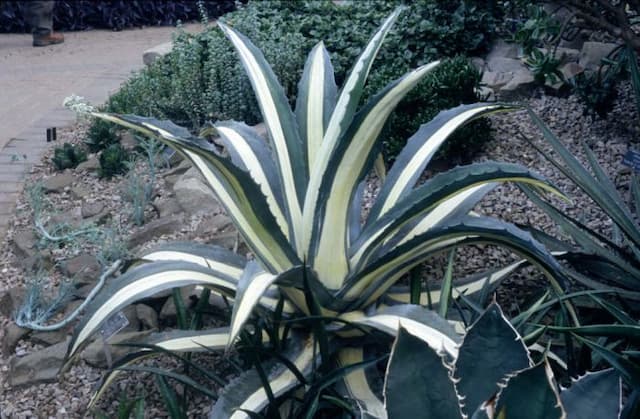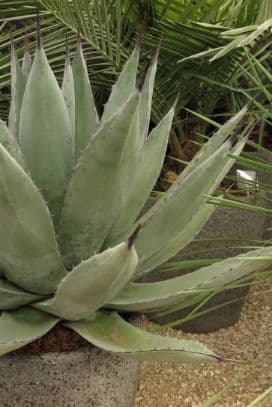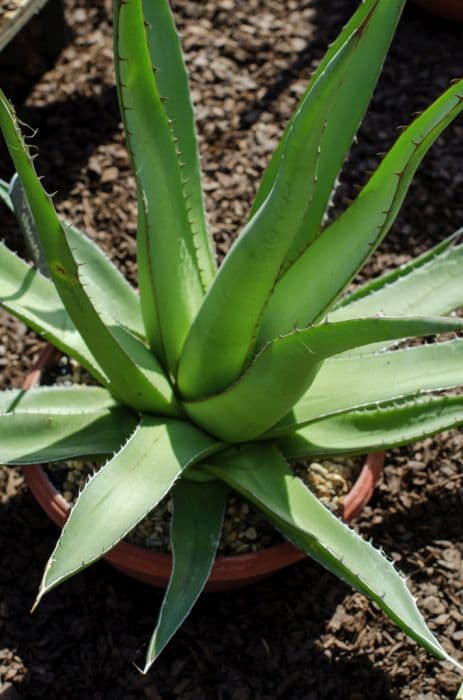Summer Hyacinth Galtonia candicans

ABOUT
Galtonia candicans, commonly known as summer hyacinth, is a bulbous perennial that exhibits a distinctive and elegant appearance. The plant is characterized by its lush green, strap-shaped leaves that emerge in a basal rosette. During its blooming season, the summer hyacinth produces tall flower spikes on which hang numerous bell-shaped flowers. These flowers are typically pure white and gracefully dangle from the spike, exuding an ethereal look. They are arranged in a dense raceme and provide a fresh, airy feeling in the garden. The contrast between the white flowers and dark green foliage adds to its visual appeal, making the summer hyacinth a popular choice for ornamental gardens. The blossoms are particularly known for their sweet, enticing fragrance, which becomes more pronounced in the evenings. The plant's bulb is where it stores its energy, allowing it to survive through different seasons. With its soothing color palette and fragrance, the summer hyacinth is a delightful addition to any outdoor space, bringing with it a sense of tranquility and charm.
About this plant
 Names
NamesFamily
Asparagaceae
Synonyms
Summer Hyacinth, Cape Hyacinth, Spire Lily, Berg Lily
Common names
Hyacinthus candicans, Ornithogalum candicans.
 Toxicity
ToxicityTo humans
Summer hyacinth, the common name for Galtonia candicans, is not extensively documented for its toxicity to humans. However, as with many bulb plants, it's prudent to be cautious and avoid ingestion because bulbs often contain compounds that can be toxic. If a person ingests parts of Summer hyacinth, they could potentially experience stomach upset or more serious symptoms depending on the amount consumed and individual sensitivity. However, specific symptoms of poisoning from this particular plant are not well-documented. If ingestion occurs, medical advice should be sought.
To pets
Summer hyacinth might not be specifically listed as a toxic plant to pets, but many plants in the bulb family can be toxic to animals. It is recommended to keep pets away from Summer hyacinth as a precaution. If a pet ingests part of the plant, especially the bulb, it could lead to gastrointestinal upset, and symptoms could include vomiting, diarrhea, or drooling. In some cases, more severe symptoms could manifest, dependent on the quantity eaten and the size and health of the pet. If suspected poisoning occurs, seek veterinary attention promptly.
 Characteristics
CharacteristicsLife cycle
Perennials
Foliage type
Deciduous
Color of leaves
Green
Flower color
White
Height
4 feet (1.22 meters)
Spread
1 foot (0.30 meters)
Plant type
Bulb
Hardiness zones
7
Native area
South Africa
Benefits
 General Benefits
General Benefits- Ornamental value: The Summer Hyacinth features tall spires of white bell-shaped flowers that add aesthetic appeal to gardens.
- Attracts pollinators: Bees and other pollinators are drawn to the flowers, which supports biodiversity.
- Drought resistance: Once established, it can tolerate periods of drought, making it suitable for xeriscaping.
- Easy to grow: It is considered easy to cultivate and can thrive in a variety of soil types, as long as there is good drainage.
- Cut flower use: The long stems and showy flowers make excellent cut flowers for arrangements.
- Deer resistance: Generally, deer tend to avoid eating the plants, which is beneficial in areas where deer predation is a problem.
 Medical Properties
Medical PropertiesThis plant is not used for medical purposes.
 Air-purifying Qualities
Air-purifying QualitiesThis plant is not specifically known for air purifying qualities.
 Other Uses
Other Uses- Summer Hyacinth is often used as a cut flower in floral arrangements due to its long stems and bell-shaped white blooms providing an elegant touch to bouquets.
- The bulbs of Summer Hyacinth can be used for forcing in pots indoors to enjoy their flowers out of season, typically during the winter months for a touch of spring.
- In areas with suitable climates, Summer Hyacinth bulbs can naturalize in the garden, slowly spreading to create larger displays over the years.
- Summer Hyacinth's vertical flower spikes can be used as a living trellis to support or contrast with lower-growing trailing plants in mixed borders.
- Gardeners frequently use Summer Hyacinth in moon gardens, where its bright white flowers stand out in the evening and attract nocturnal pollinators.
- The plant can be used as a transition element between early-summer and late-summer flowering plants in perennial borders, filling gaps in bloom times.
- In cottage gardens, Summer Hyacinth adds an old-fashioned charm and vertical structure without overwhelming other plants.
- Because of its stately form, Summer Hyacinth is used to create focal points in large container plantings on patios or balcony gardens.
- When planted in a large swath, Summer Hyacinth can serve as an informal summer screen or a green backdrop for outdoor living spaces.
- Illustrators and photographers may use the unique shape of Summer Hyacinth blooms as subjects for botanical art and garden photography, capturing its grace and structure.
Interesting Facts
 Feng Shui
Feng ShuiThe Summer Hyacinth is not used in Feng Shui practice.
 Zodiac Sign Compitability
Zodiac Sign CompitabilityThe Summer Hyacinth is not used in astrology practice.
 Plant Symbolism
Plant Symbolism- Purity: The crisp, white bell-shaped blossoms of the Galtonia candicans, commonly known as "Summer Hyacinth," symbolize purity and innocence.
- Peace: The gentle sway of Summer Hyacinth's flowers can evoke a sense of tranquility, making them a symbol of peace and calm.
- Gratitude: Often given as a sign of thankfulness, this plant serves as a token of appreciation for a kind gesture or help received.
- Healing: In some cultural traditions, the delicate appearance of the Summer Hyacinth may represent recovery and the wish for someone's health to improve.
- Spiritual Enlightenment: The way its flowers reach towards the sky can be seen as a metaphor for human striving for knowledge and spiritual growth.
 Water
WaterFor the Summer Hyacinth, water it thoroughly once a week during the active growing season, ensuring that the soil is moist but not waterlogged. Reduce the frequency of watering once the flower starts to die back, as overwatering at this stage can lead to bulb rot. Depending on the size of the plant and the environmental conditions, you may need to adjust the quantity, but as a general guideline, use about 1-2 gallons of water per plant each time you water. During the dormant period in the winter, watering should be minimal to prevent the bulbs from rotting.
 Light
LightSummer Hyacinth thrives best in full sun to partial shade. The ideal spot for this plant is one where it can receive at least six hours of sunlight each day. However, some dappled afternoon shade can be beneficial, especially in very hot climates, to prevent the leaves from scorching.
 Temperature
TemperatureSummer Hyacinth can survive in a temperature range from 50°F to 90°F, but it prefers a temperate climate. The ideal temperature for optimal growth is between 60°F and 70°F. It should be protected from frost, as temperatures below 50°F can damage or kill the plant.
 Pruning
PruningSummer Hyacinth benefits from pruning after the flowers have faded and the foliage starts to yellow, as this helps direct energy back into the bulbs for next year's growth. Cut back the dead foliage and stems to just above the ground level. Pruning is typically done annually, in the fall, after the plant has finished blooming.
 Cleaning
CleaningAs needed
 Soil
SoilThe best soil mix for the Summer Hyacinth (common name for Galtonia candicans) is well-draining, loamy soil with added organic matter like compost to ensure fertility. The soil pH should be neutral to slightly acidic, around 6.5 to 7.0.
 Repotting
RepottingSummer Hyacinths typically do not require frequent repotting. It's best to repot these plants every 3-4 years as they can comfortably grow in the same pot until they become overcrowded.
 Humidity & Misting
Humidity & MistingSummer Hyacinth prefers moderate humidity but is quite adaptable. However, it does not require any special humidity requirements, thriving in typical room humidity levels.
 Suitable locations
Suitable locationsIndoor
Place in bright, indirect sunlight and avoid over-watering.
Outdoor
Full sun to partial shade and protect from strong winds.
Hardiness zone
7-10 USDA
 Life cycle
Life cycleGaltonia candicans, commonly known as summer hyacinth, begins its life cycle as a bulb, which will typically remain dormant during the winter. In spring, the bulb breaks dormancy and sends up long, strap-like leaves, followed by tall flower spikes that can reach up to 4 feet, blooming usually in mid to late summer with fragrant white bell-shaped flowers. After flowering, the plant sets seed, which can be dispersed by wind or collected for propagation. As the flowering ends, the foliage begins to yellow and wither, indicating the plant is entering a period of dormancy. During this dormant phase, the bulb conserves energy to survive the winter and re-emerge in the next growing season. For continual growth, the bulbs can be divided every few years in early spring or autumn.
 Propogation
PropogationPropogation time
Summer
The most popular method of propagation for the Summer Hyacinth, or Galtonia candicans, is through division of its bulbs. The ideal time for this process is in the autumn after the foliage has died back or in early spring before growth resumes. To propagate, one should carefully lift the clump of bulbs from the ground with a spade, ensuring minimal damage to the bulbs. Once removed, the bulbs can be gently separated by hand, with each bulb ideally having a portion of the base plate from which roots grow. After division, the bulbs should be replanted at a depth of about 5 to 6 inches (approximately 12.7 to 15.2 centimeters) with the pointed end facing upwards, and spaced approximately 8 to 10 inches (about 20 to 25 centimeters) apart to allow sufficient room for growth.









